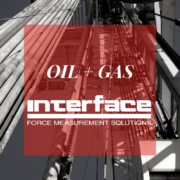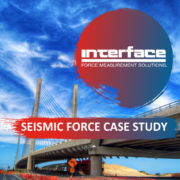Examining Force Measurement in Subsea Oil and Gas
 Precision and reliability are paramount in the demanding environment of subsea oil and gas operations. Subsea projects, often thousands of meters below sea level, present unique challenges with immense pressure, corrosion, and extreme temperatures.
Precision and reliability are paramount in the demanding environment of subsea oil and gas operations. Subsea projects, often thousands of meters below sea level, present unique challenges with immense pressure, corrosion, and extreme temperatures.
Interface designs and manufacturers load cells and other force measurement devices for this type of setting, enabling operators to measure, monitor, and control loads, weighing, compression, and tension to ensure safety and operational efficiency.
The subsea oil and gas industry is experiencing a surge in deepwater and ultra-deepwater exploration and production activities. Estimates are that offshore exploration globally will grow by 30-40% in the next few years. As conventional reserves dwindle, the demand for hydrocarbons necessitates venturing into harsher and more remote environments. This trend drives the need for robust, reliable subsea technologies, including advanced force measurement solutions.
Force measurement solutions for applications, including pipeline integrity monitoring, riser tension monitoring, and wellhead fatigue analysis, are essential in subsea projects. Accurate force measurement ensures the safety and efficiency of subsea operations, preventing costly failures and environmental damage.
The increasing complexity of subsea infrastructure and the growing emphasis on long-term asset integrity amplify the demand for sophisticated force measurement technologies.
Interface is a supplier of choice to the maritime and energy industries. We work with our partners to provide standard off-the-shelf measurement devices, engineered-to-order sensors like our hazardous environments wireless load pins and sealed load cells, and complete custom solutions for submersible, ATEX requirements, and IP-rated environments. Interface has the knowledge and experience to ensure that our products meet the high-intensity needs of the subsea oil and gas market.
Subsea oil and gas projects involve heavy equipment, pipelines, and drilling operations that must withstand extreme conditions. Reliable force measurement helps mitigate risks associated with these high-stakes environments, including structural failures, equipment damage, and environmental hazards.
Benefits of integrating force measurement into a subsea oil and gas project include:
- Structural Integrity: Monitoring the strain and tension on critical structures like risers, flowlines, and mooring systems.
- Operational Control: Ensuring machinery like blowout preventers and drilling rigs operate within safe limits.
- Safety Assurance: Providing data that helps prevent catastrophic failures, safeguarding personnel and the environment.
- Production Efficiency: Accurate force measurement allows precise machinery control, leading to smoother, more efficient operations and reduced energy consumption.
- Proactive Maintenance: By providing real-time data on stress and load, load cells enable operators to detect early signs of wear and tear, helping prevent costly repairs and downtime. The most significant demand for measurement solutions in subsea oil and gas is real-time condition monitoring and predictive maintenance. The industry is increasingly focused on maximizing the lifespan of subsea assets and preventing costly downtime.
Implementing load cells and force measurement devices in subsea projects requires careful planning, especially regarding the environment in which they are deployed. Interface provides a range of product options to ensure the solution meets the project’s environmental demands.
Corrosion resistance is essential in subsea environments. Load cells must be made from materials to withstand the corrosive effects of saltwater. Pressure endurance is also critical, as load cells must operate reliably at extreme depths where pressures can exceed 10,000 psi, necessitating rigorous durability testing.
Additionally, reliable data transmission is crucial, and advanced communication technology, such as fiber optics, ensures accurate data transfer from load cells to surface facilities, even at great depths.
Subsea Oil and Gas Applications and Use Cases
Liquefied Natural Gas Project Solution
 Interface’s specialty sensor company, LCM Systems, designed this 1500kN Ex d (explosion-proof) load pin. It will be used on an LNG project involving converting a semi-submersible drilling unit into a separation and boosting plant that will receive production fluids and separate the gas from the liquids.
Interface’s specialty sensor company, LCM Systems, designed this 1500kN Ex d (explosion-proof) load pin. It will be used on an LNG project involving converting a semi-submersible drilling unit into a separation and boosting plant that will receive production fluids and separate the gas from the liquids.
The load pin must be suitable for use in a Zone 1 hazardous area due to the environment where it will operate. It is supplied with IECEx, ATEX certification, and a 3.1 material certificate for traceability. The load pin has an integral amplifier to provide a 4-20mA output, allowing direct connection via a 50-meter-long cable to an Ex-d-approved stainless-steel display.
Riser Tension Monitoring
Risers are vertical pipes connecting the seabed to surface facilities. Due to dynamic ocean conditions, they are subject to constant movement and stress. Load cells help monitor riser tension, providing data for controlling tension systems. This is crucial for maintaining structural integrity and preventing riser fatigue.
Pipeline and Flowline Stress Monitoring
Pipelines transport oil and gas from wells to processing facilities. These pipelines face constant internal and external pressures, making stress monitoring essential. Load cells help measure pipeline strain and bending forces, enabling operators to detect early signs of failure or damage.
Anchor and Mooring System Tension
Offshore platforms and rigs are secured to the seabed by mooring systems, which must withstand strong currents and waves. Load cells monitor the tension on these systems, helping operators ensure stability and safety, particularly in deepwater environments.
Drilling and Lifting Operations
During drilling and equipment lifting operations, load cells measure force to ensure machinery is not overloaded, reducing the risk of equipment failure. Load cells in cranes, winches, and drilling systems help maintain operational control, ensuring efficiency and preventing breakdowns.
As subsea oil and gas projects venture into even deeper waters, the demand for robust force measurement technology will only increase. Emerging technologies like wireless subsea load cells and advanced data analytics pave the way for real-time remote monitoring, enabling operators to make data-driven decisions from shore.
Operators must continuously monitor stress, strain, and fatigue by integrating sensors into critical components like pipelines, risers, and mooring lines. This data allows for early detection of potential issues, enabling proactive maintenance and preventing catastrophic failures. This translates to significant cost savings, improved safety, and reduced environmental impact. Moreover, the growing adoption of digitalization and IoT in the industry further amplifies the demand for real-time data acquisition and analysis, making advanced force measurement solutions indispensable for intelligent subsea asset management.
Our measurement devices, including load cells, torque transducers, load pins, shackles, and tension load links, support the demands of subsea oil and gas operations. Our wireless and Bluetooth telemetry system components, ruggedized capabilities, and enclosures support continuous monitoring and measurement analysis for these environments.
These solutions enable operators to monitor forces, maintain structural integrity, and ensure safety in some of the most challenging conditions on Earth.









